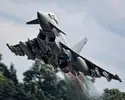In the Bundeswehr, there is a growing dissatisfaction with the situation in the armed forces in many places: Too many or too old material, increasing bureaucracy and little chance of improvement determine their daily routine for too many soldiers. This is nothing really new and is often discussed here. In public, this rarely occurs; in a professional group in the Bundeswehr, however, it is noted: Even among the pilots of fighter jets dissatisfaction grabs around.
At least seven pilots who have been flying the Eurofighter have already submitted their resignations this year and have left the armed forces - and it is likely that they will be heard from the troop.
Among those who go are
straightforward, according to information of
eyes! also a deputy squadron commander and several flight instructors (which is officially not confirmed for comprehensible data protection reasons).
One of the rare female pilots in the Bundeswehr publicly explained last week why she is leaving the armed forces.
Nicola Baumann, trained both on the Tornado and on the Eurofighter, five years ago
Flight Commander of the Year, flight instructor - and, one must understand, driven by the bureaucracy from the troupe.
On her Facebook page, Baumann explained her reasons for leaving on her last day at work. From it as a longer quote by kind permission of the author:
Today is my last active day in the service of the German Armed Forces and so I say goodbye to this wonderful prospect after more than ten years of active jet-flying and almost 14 years on duty. (...)
At the age of 19, I went to the German Armed Forces immediately after graduating from high school and signed a declaration of commitment to a temporary soldier over the age of fifteen. Alone this time seemed to me then already incredibly long. And I thought I was pretty old when that was over. I went to the Air Force back then because I really wanted to fly those wonderful planes - and because my work should have a higher meaning.A sense of our community.
After passing my jet training, I became "BO 41" without request or much effort. This is called professional officer with the special age limit 41. In German - I should fly Jets until the 41st birthday and then go home with a (about 50% -) pension. For my life that was the perfect plan and most attractive! I have only one life ... and to be able to try more than one job and more than one employer was always my wish and my dream! For me, a "career" is not desirable and successful, if you go as far as possible "up". But much more if this career is as varied, interesting, challenging and fulfilling.
About eight or nine years ago, the Bundeswehr decided to gradually abolish the BO41 status. One and a half years ago I was told that from now on I would be a "normal" career officer. This means to be expected to 67 in the Bundeswehr. Of which probably more than 25 years not flying!
Now 41 years would be more difficult to build a second career than it is at 33. And my time with the Air Force has no officially defined end before the absolute end of my professional life. So, if I want to do that, I can and can define my own end of service myself. That's what the legislator says. And I do. In civilian life, this is called "termination" and is the most normal thing in the world. Especially after such a long time.
I can not judge if Baumann just kindly deals with the Bundeswehr. Because so comprehensible the conversion of a promised at service status as reason for termination is: From the troupe I also hear - in addition - other reasons for the dismissal decision of the various pilots. First and foremost the lack of flight hours, because too many Eurofighters have to stay on the ground too often.
As a reminder from the
latest report on the material situation of the main weapon systems on Eurofighter:
The Luftwaffe had an average of 81 aircraft in the period under review. On average, 39 aircraft were ready for use; this corresponds on average to a material commitment of approx. 48%.
The material conservation concept provides a strong support to the industry. Therefore, maintenance and upgrading measures in the industry directly affect the available stock.
For this continued unsatisfactory ratio of inventory to total inventory remained unchanged long-lasting maintenance and the lack of various spare parts responsible. Introduced procurement measures can only have a medium-term effect due to long delivery times. Although the availability agreement for spare parts, which began in August 2016, has contributed to a first stabilization of the replacement part location, it has not yet led to an increased operational readiness of the aircraft.
But the motivation for pilots to join the Bundeswehr is a little different to that of most soldiers: they want to fly first of all. And if they do not fly because the machines are down, they can not see any prospects for their future career. Or, to stay in the jargon of the Ministry of Defense: No attractiveness.
The official response of the Luftwaffe to the question of this, one can almost say wave of dismissal: There are each and every individual reasons. That may not be wrong.But many individual reasons also show a trend. And he just does not look good.

 Mutta itse kyllä uskon mariinien ja jalkaväen osaltaan painostavan ihan oikean maataistelukoneen saamiseen.
Mutta itse kyllä uskon mariinien ja jalkaväen osaltaan painostavan ihan oikean maataistelukoneen saamiseen.
